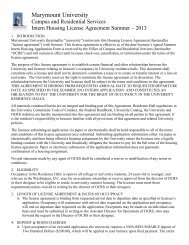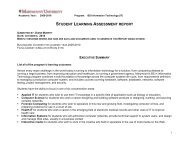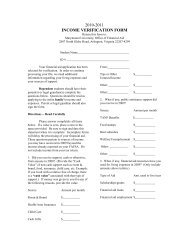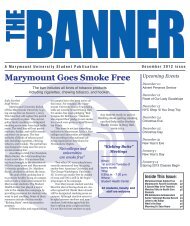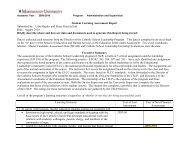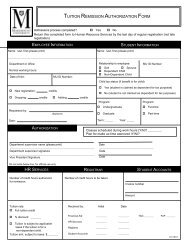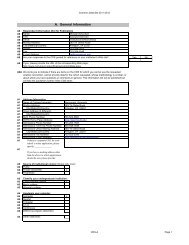STUDENT LEARNING ASSESSMENT PLAN - Marymount University
STUDENT LEARNING ASSESSMENT PLAN - Marymount University
STUDENT LEARNING ASSESSMENT PLAN - Marymount University
Create successful ePaper yourself
Turn your PDF publications into a flip-book with our unique Google optimized e-Paper software.
Academic Year : 2008/2009 Program: Interior Design Undergraduate<br />
<strong>STUDENT</strong> <strong>LEARNING</strong> <strong>ASSESSMENT</strong> <strong>PLAN</strong><br />
RE-SUBMITTED BY: ROBIN WAGNER<br />
DATE: SEPTEMBER 2010<br />
BRIEFLY DESCRIBE WHERE AND HOW ARE DATA AND DOCUMENTS USED TO GENERATE THIS REPORT BEING STORED:<br />
DIGITALLY WITH CHAIR AND ASSISTANT CHAIR OF DEPARTMENT AND FILED IN BACKUP DISC W/ RJ WAGNER<br />
EXECUTIVE SUMMARY<br />
List all of the program’s learning outcomes: (regardless of whether or not they are being assessed this year)<br />
Learning Outcome<br />
Year of Last<br />
Assessment<br />
Year of Next Planned<br />
Assessment<br />
Learning Outcomes are based on criteria set forth by NCIDQ (National Council for<br />
Interior Design Qualification) and CIDA (Council for Interior Design Accreditation).<br />
1. Students will capably use quantitative and qualitative skills to evaluate and 2008/2009 2011/2012<br />
assess project goals and objectives<br />
2. Students will effectively formulate qualitative schematic design skills to develop 2008/2009 2011/2012<br />
solutions incorporating human factors, ADA and universal requirements, and<br />
environmental elements and responses.<br />
3. Students will effectively formulate quantitative design development skills to 2008/2009 2011/2012<br />
develop solutions incorporating building and life safety codes; furniture, fixtures and<br />
equipment (FF&E) requirements; and the built environment.<br />
4. Students will exhibit the ability to read, interpret, and create contract documents. Never 2011/2012<br />
5. Students will demonstrate an understanding of contract administration and the<br />
legal and ethical business practices of interior design.<br />
2007/2008<br />
partial<br />
2011/2012<br />
Describe how the program’s outcomes support <strong>Marymount</strong>’s Mission, Strategic Plan, and relevant school plan:<br />
The Bachelor of Arts program in interior design is accredited by CIDA (Council for Interior Design Accreditation; formerly FIDER),<br />
reaccredited in 2004. The interior design program has maintained continuous accreditation since 1985. The programs main mission<br />
is to prepare students to be entry level interior designers in the field of interior design. Our learning outcomes both support and are in<br />
line with CIDA’s accreditation criteria’s and with NCIDQ’s (National Council for Interior Design Qualifications) projected areas of<br />
1
Academic Year : 2008/2009 Program: Interior Design Undergraduate<br />
knowledge qualification for candidacy to sit for the professional exam certifying interior designers. Many of ours student take the<br />
exam after school – we prepare them for eligibility upon graduation and with two to three years of work experience in the field.<br />
Additionally, we uphold the universities mission toward providing an education that fosters inquiry and self discovery in the<br />
programmatic, schematic and design development stages of our learning outcomes. We also support and further ethical behavior<br />
and responsibility on the students part in our teachings in studio and lecture classes and have defined these in our learning<br />
outcomes.<br />
Provide a brief description of the assessment process used including strengths, challenges and planned improvements:<br />
Leaning Outcomes 1, 2 and 3 are assessed in ID 406: Capstone Course. Final interior design studio (ID 406 Interior Design<br />
Studio VI) by the instructor and outside jurors who are professional practitioners in either interior design or architecture. Students<br />
projects are self selected and project developed on their own with faculty supervision. Projects content include healthcare design,<br />
daycare designs, hospitality design, and retail design.<br />
Instructors for the academic year 2009/2010 –Spring ID 406A taught by Robin Wagner and Fall and Spring ID 406B taught by<br />
Margaret Konkel. Summer ID 406 A-3 taught by Douglas Seidler. Professional critics throughout the Washington DC area are used<br />
to evaluate the students work; the following list is some of those evaluators:<br />
Karen Trimbach, IIDA, NCIDQ certified, LEED AP<br />
Terry Perry, IIDA, NCIDQ certified, LEED AP<br />
Susan Herganrother, Allied member ASID, Adjunct Professor<br />
Susan Tully, IIDA, NCIDQ certified, LEED AP<br />
Robert Kelly, IIDA, NCIDQ certified<br />
Robert McGuire, NCIDQ certified<br />
Richard Fannelli, AIA, Leed AP<br />
Randall Mars, AIA<br />
The course blueprint is comparative to the design process stages of interior design. Students have professional critiques at each end<br />
of these stages (or phases): Phase I: Programming assessment stage, Phase II: Schematic, concept development, Phase III: Design<br />
development, Phase IV: Design specification and implementation. Three times during the semester, (Phase I, II and III) professional<br />
jurors critique students’ work, providing additional support and direction. Jurors also attend and evaluate the final presentations.<br />
At these professional juried critiques, rubrics, outlining expected student outcomes, are provided to jurors to assess student<br />
performance (See attachments, ID 404 Phase I critique, Phase II critique and Phase III critique).<br />
2
Academic Year : 2008/2009 Program: Interior Design Undergraduate<br />
Learning outcome 4: There are currently no set up for assessment for this outcome in place. The academic year 2009/2010<br />
evaluation tools are being put into to place to assess this outcome.<br />
Learning outcome 5: Internship Employer Evaluations. Interior design students complete internships for a total of 6 credit hours.<br />
Employer evaluations meet the needs of interior standards for interior design minimum proficiency as defined by both NCIDQ<br />
(National Council for Interior Design Qualification) and CIDA (Council for Interior Design Accreditation) practice analysis assessment<br />
and have been created as an assessment tool for student’s application of knowledge and skills in workplace environment. MU interior<br />
design student’s internships are conducted at commercial firms, architectural firms, residential firms, retail firms and showrooms.<br />
(See Attachment : ID 400 Employer Evaluation)<br />
The employer evaluations only give a small “snap shot” of what the students are learning in the area of contract administration and<br />
business practice. A more thorough assessment of this learning outcome would to be to concentrate on the course ID 436: Business<br />
Practice and define some assessment tools to evaluate further these learning outcomes. Fall 2010, the mid-term and final exam will<br />
also be used as assessment tool for this learning outcome and additional learning outcomes identified in program review for CIDA<br />
accreditation..<br />
Learning Outcome 1: Students will capably use quantitative and qualitative skills to evaluate and assess project goals and<br />
objectives.<br />
Programmatic inquiry is the heart of design problem – thus, the programs main “inquiry outcome”. Programming is two pronged –<br />
discovery of information both qualitative and quantitative that is tested in the following stages: qualitative in the schematic stage and<br />
quantitative in the design development stage.<br />
This “inquiry outcome” in the future assessment 2011/2012 will be assessed in the following courses:<br />
ID 201: Studio I. Students are first introduced to the foundations of the design phases to evaluating design environments,<br />
human factors, end user needs and beginning ADA, universal and building, life safety codes.<br />
ID 303: Studio 4. Students deal with a larger, more complex project in this studio classroom. Incorporated are more variables<br />
of end users within the space and components of human factors where ADA , universal, and building, life safety codes.<br />
3
Academic Year : 2008/2009 Program: Interior Design Undergraduate<br />
ID 406: Studio 6. Student’s capstone course in interior design. Incorporates all the stages of design and students must show<br />
how they are incorporating human factors, ADA, universal, and building, life, safety codes into the final design solution.<br />
Describe how the program implemented its planned improvements from last year:<br />
No implementation changes. Senior Comprehensive Exam not administered during this assessment period.<br />
Provide a response to last year’s <strong>University</strong> Assessment Committee review of the program’s learning assessment report:<br />
(List each recommendation and provide a specific response to each).<br />
From Report provided January 2009<br />
From Report provided January 2010<br />
Define outcomes in a simplistic form.<br />
Outcomes have been changed – are in simplified format for catalogue and continue to meet the fundamental definition both NCIDQ and CIDA<br />
term Interior Designers: problem solvers.<br />
In the design process for problem solving, this has been identified into the following stages by NCIDQ and CIDA:<br />
Programmatic, Schematic Design, Design Development, Contract Documentation, Contract Administration, and Professional Practice<br />
Our outcomes for our students have been defined by these stages and in addition we will design assessing mechanisms to assess all areas for<br />
the 2011/2012 academic year after looking at the program that is in review for the spring 2011 CIDA accreditation visit.<br />
4
Academic Year : 2008/2009 Program: Interior Design Undergraduate<br />
Outcome and Past Assessment<br />
Learning Outcome 1 Students will capably use quantitative and qualitative skills to evaluate and assess project goals and<br />
objectives<br />
Is this outcome being reexamined? Yes No<br />
If yes, give a brief summary of previous results (including trends) and any changes made to the program.<br />
Assessment Activity<br />
Outcome Measures<br />
Explain how student learning<br />
will be measured and indicate<br />
whether it is direct or indirect.<br />
The outcome measures are<br />
developed by assessing<br />
outside professionals critics<br />
evaluation of student<br />
performances – using<br />
rubrics to assess the<br />
students in the skill areas<br />
of: programming skills,<br />
Research, Concept Design<br />
development, Verbal and<br />
Graphic Presentation Skills.<br />
These are used as direct<br />
measures for the<br />
department’s assessment<br />
of program outcomes.<br />
Performance Standard<br />
Define and explain acceptable<br />
level of student performance.<br />
Rubric Evaluation,<br />
75% of the students<br />
will receive a rating<br />
of 4 or better in<br />
performance<br />
standards.<br />
Data Collection<br />
Discuss the data collected and<br />
student population<br />
ID 406: Capstone Course.<br />
These include evaluations of<br />
student work from the final<br />
interior design studio (ID 406<br />
Interior Design Studio VI) by<br />
the instructor and outside<br />
jurors who are professional<br />
practitioners in either interior<br />
design or architecture.<br />
Students projects are self<br />
selected and project developed<br />
on their own with faculty<br />
supervision. Projects content<br />
include healthcare design,<br />
daycare designs, hospitality<br />
design, and retail design<br />
Analysis<br />
1) Describe the analysis process.<br />
2) Present the findings of the analysis including the<br />
numbers participating and deemed acceptable.<br />
27 of 35 Senior ID students included<br />
in analysis<br />
11 raters<br />
77% above<br />
23% below<br />
5
Academic Year : 2008/2009 Program: Interior Design Undergraduate<br />
Interpretation of Results<br />
INCLUDE ONLY INFORMATION FOR THIS PARTICULAR <strong>LEARNING</strong> OUTCOME<br />
Extent this Learning Outcome has been achieved by students (Use both direct and indirect measure results):<br />
On average, over 94% of students obtained a rating of three (3) or better from professional jurors. Breakdown of the outcome:<br />
Research and code research, student ratings 4 or better cross the threshold at 82%; concept development student ratings 4 or better<br />
cross below the threshold at 75%; Goals and objectives student ratings 4 or better cross below the threshold at 72%;and, Program<br />
Development student ratings 4 or better cross the threshold at 78%.<br />
The Students in this period of the assessment have met this learning outcome.<br />
Program strengths and opportunities for improvement relative to assessment of outcome:<br />
Outcome Program Strengths continue to be in the area of research, and program development. And improvement skill in the area of<br />
Goals and Objectives; however this measure remains slightly below the 75<br />
% threshold.<br />
Program weaknesses: juror grading and comments in the area of concept development show students still slightly weak however are<br />
adopting concept better into project developments and understanding and remains at a steady 75% threshold rating. . Weakest area<br />
is in defining project goals and objectives. Although this area of assessment is below the 75% threshold, there has been a<br />
improvements (up 4% in goals and objectives from 2008/2009 assessment). Additionally, students are identified for effectiveness in<br />
code research; however, need for separate identification of students efficiency in application of information into planned designs.<br />
Discuss planned curricular or program improvements for this year based on assessment of outcome:<br />
It has been decided by the ID faculty to assess additional studio courses (earlier) to help identify program strengths and weaknesses.<br />
The hope is to identify whether these are programmatic issues or anomalies in students going through the program at the time. The<br />
courses identified for assessment are sophomore studio course ID 201 and junior studio course ID 304. Means of assessing these<br />
earlier skills will be set in motion for the next assessment period -- along with looking at outcomes for the program review being<br />
implemented for CIDA Accreditation in spring 2011.<br />
6
Academic Year : 2008/2009 Program: Interior Design Undergraduate<br />
Learning Outcome 2. Students will effectively formulate qualitative schematic design skills to develop solutions incorporating<br />
human factors, ADA and universal requirements, and environmental elements and responses.<br />
Is this outcome being reexamined? Yes No<br />
If yes, give a brief summary of previous results (including trends) and any changes made to the program.<br />
Assessment Activity<br />
Outcome Measures<br />
Explain how student learning<br />
will be measured and indicate<br />
whether it is direct or indirect.<br />
The outcome measures are<br />
developed by assessing<br />
outside professionals critics<br />
evaluation of student<br />
performances – using<br />
rubrics to assess the<br />
students in the skill areas<br />
of: programming skills,<br />
Research, Concept Design,<br />
Space Planning,<br />
Visual/Graphic<br />
Communication,<br />
Verbal/Graphic<br />
Presentation Skills. These<br />
are used as direct<br />
measures for the<br />
department’s assessment<br />
of program outcomes.<br />
Performance Standard<br />
Define and explain acceptable<br />
level of student performance.<br />
Rubric Evaluation,<br />
75% of the students<br />
will receive a rating<br />
of 4 or better in<br />
performance<br />
standards.<br />
Data Collection<br />
Discuss the data collected and<br />
student population<br />
ID 406: Capstone<br />
Course. These include<br />
evaluations of student<br />
work from the final<br />
interior design studio (ID<br />
406 Interior Design<br />
Studio VI) by the<br />
instructor and outside<br />
jurors who are<br />
professional practitioners<br />
in either interior design or<br />
architecture. Students<br />
projects are self selected<br />
and project developed on<br />
their own with faculty<br />
supervision. Projects<br />
content include<br />
healthcare design,<br />
daycare designs,<br />
hospitality design, and<br />
retail design<br />
Analysis<br />
1) Describe the analysis process.<br />
2) Present the findings of the analysis including the<br />
numbers participating and deemed acceptable.<br />
27 of 35 Senior ID students included in<br />
analysis<br />
11 raters<br />
75% above<br />
25% below<br />
7
Academic Year : 2008/2009 Program: Interior Design Undergraduate<br />
Interpretation of Results<br />
Extent this Learning Outcome has been achieved by students (Use both direct and indirect measure results):<br />
On average, 90% of the student have a rating of three(3) or better.<br />
Breaking down the outcome: Floor plan development students ratings 4 or better crossed just below the threshold at 75%; Schematic<br />
planning student ratings 4 or better crossed the threshold at 78%, down from 2008/2009 assessment; 3D Development Sketches<br />
students ratings 4 or better crossed threshold at 77%, up from the 2008/2009 assessment; Concept development students rating 4 or<br />
better crossed at the threshold 75%; and elevations and details students ratings 4 or better crossed the threshold at 75%, also up<br />
from the 2008/2009 assessment.<br />
The students in this period of the assessment have met the learning outcome.<br />
Program strengths and opportunities for improvement relative to assessment of outcome:<br />
Program Strengths are in the area of schematic planning. In the area of 3D development sketches and detail and elevations, each of<br />
the skills have increased from the 2008/2009 assessment. . In this area professional jurors comment that students either excel in<br />
their sketches or are too dependent on their computer and do not use sketching or computer 3D modeling as a necessary tool for<br />
understanding the built environmentin 2008/2009…new comments are in the area of combining technological skills with hand<br />
sketching to better understand the built-environment..<br />
Program weaknesses: Although the area of concept development just meets the 75% threshold, this area due to juror comments still<br />
remains an area of weakness.<br />
Discuss planned curricular or program improvements for this year based on assessment of outcome:<br />
It has been decided by the ID faculty to assess additional studio courses (earlier) to help identify program strengths and weaknesses.<br />
The hope is to identify whether these are programmatic issues or anomalies in students going through the program at the time. The<br />
courses identified for assessment are sophomore studio course ID 201 and junior studio course ID 304. Means of assessing these<br />
earlier skills will be set in motion for the next assessment period -- along with looking at outcomes for the program review being<br />
implemented for CIDA Accreditation in spring 2011.<br />
8
Academic Year : 2008/2009 Program: Interior Design Undergraduate<br />
Learning Outcome 3. Students will effectively formulate quantitative design development skills to develop solutions incorporating<br />
building and life safety codes; furniture, fixtures and equipment (FF&E) requirements; and the built environment.<br />
Is this outcome being reexamined? Yes No<br />
If yes, give a brief summary of previous results (including trends) and any changes made to the program.<br />
Assessment Activity<br />
Outcome Measures<br />
Explain how student learning<br />
will be measured and indicate<br />
whether it is direct or indirect.<br />
The outcome measures are<br />
developed by assessing<br />
outside professionals critics<br />
evaluation of student<br />
performances – using<br />
rubrics to assess the<br />
students in the skill areas<br />
of: programming skills,<br />
Research, Concept Design,<br />
Space Planning,<br />
Visual/Graphic<br />
Communication,<br />
Ceiling/Lighting<br />
Components,<br />
Finish/Furnish Application,<br />
Verbal/Graphic<br />
Presentation Skills. These<br />
are used as direct<br />
measures for the<br />
department’s assessment<br />
of program outcomes.<br />
Performance Standard<br />
Define and explain acceptable<br />
level of student performance.<br />
Rubric Evaluation,<br />
75% of the students<br />
will receive a rating<br />
of 4 or above<br />
performance<br />
standards.<br />
Data Collection<br />
Discuss the data collected and<br />
student population<br />
ID 406: Capstone<br />
Course. These include<br />
evaluations of student<br />
work from the final<br />
interior design studio (ID<br />
406 Interior Design<br />
Studio VI) by the<br />
instructor and outside<br />
jurors who are<br />
professional practitioners<br />
in either interior design or<br />
architecture. Students<br />
projects are self selected<br />
and project developed on<br />
their own with faculty<br />
supervision. Projects<br />
content include<br />
healthcare design,<br />
daycare designs,<br />
hospitality design, and<br />
retail design<br />
Analysis<br />
1) Describe the analysis process.<br />
2) Present the findings of the analysis including the<br />
numbers participating and deemed acceptable.<br />
27 of 35 Senior ID students included in<br />
analysis<br />
11 raters<br />
77.0% above<br />
23.0% below<br />
9
Academic Year : 2008/2009 Program: Interior Design Undergraduate<br />
Interpretation of Results<br />
Extent this Learning Outcome has been achieved by students (Use both direct and indirect measure results):<br />
On average, 90% of the student have a rating of three(3) or better. Breaking down the outcome: Floor plan development students<br />
ratings were up from 2008/2009 assessment with ratings meeting the 75 threshold; elevations and details student ratings 4 or better<br />
crossed below the threshold at 75%, also up from 2008/2009; Finish/Furnish Selections students ratings 4 or better crossed<br />
threshold at 82%; RCP development students rating 4 or better crossed below the threshold at 72%; Presentations students ratings 4<br />
or better crossed threshold at 75%;and, Overall project student ratings 4 or better crossed the threshold at 82%.<br />
The students in this period of the assessment have met the learning outcome.<br />
Program strengths and opportunities for improvement relative to assessment of outcome:<br />
Program Strengths are in the area of Verbal and graphic presentation skills in overall presentation of final project and in appropriate<br />
selections in furniture and finish selections.<br />
Program weaknesses: juror grading and comments in the area ceiling and lighting component application are the areas of weakness.<br />
However this assessment skill is up by 4% from the 2008/2009 assessment. This still remains to be skill student tend to leave as the<br />
last component to tackle and fail to fully develop – therefore, whether this is a weakness in the program learning outcomes or failure<br />
to in student organization skills in 406 is something that needs to be identified.<br />
Discuss planned curricular or program improvements for this year based on assessment of outcome:<br />
It has been decided by the ID faculty to assess additional studio courses (earlier) to help identify program strengths and weaknesses.<br />
The hope is to identify whether these are programmatic issues or anomalies in students going through the program at the time. The<br />
courses identified for assessment are sophomore studio course ID 201 and junior studio course ID 304. ID 304 will assess<br />
construction documents and RCP’s will be a component of this to identify their understanding of ceiling and lighting components.<br />
Means of assessing these earlier skills will be set in motion for the next assessment period -- along with looking at outcomes for the<br />
program review being implemented for CIDA Accreditation in spring 2011.<br />
10
Academic Year : 2008/2009 Program: Interior Design Undergraduate<br />
Learning Outcome 4. Students will exhibit the ability to read, interpret, and create contract documents<br />
Is this outcome being reexamined? Yes No<br />
If yes, give a brief summary of previous results (including trends) and any changes made to the program.<br />
Assessment Activity<br />
Outcome Measures<br />
Explain how student learning<br />
will be measured and indicate<br />
whether it is direct or indirect.<br />
NOT ASSESSED<br />
AT THIS TIME<br />
Performance Standard<br />
Define and explain acceptable<br />
level of student performance.<br />
Data Collection<br />
Discuss the data collected and<br />
student population<br />
Analysis<br />
1) Describe the analysis process.<br />
2) Present the findings of the analysis including the<br />
numbers participating and deemed acceptable.<br />
Outcome and Past Assessment<br />
11
Academic Year : 2008/2009 Program: Interior Design Undergraduate<br />
Learning Outcome 5: Students will demonstrate an understanding of contract administration and the legal and ethical business<br />
practices of interior design.<br />
Is this outcome being reexamined? Yes No<br />
If yes, give a brief summary of previous results (including trends) and any changes made to the program.<br />
Assessment Activity<br />
Outcome Measures<br />
Explain how student learning<br />
will be measured and indicate<br />
whether it is direct or indirect.<br />
Students in the<br />
undergraduate programs<br />
take 6 credit hours of ID<br />
400: Internship. The course<br />
requires an evaluation from<br />
the employer on work skills.<br />
We use these evaluations<br />
as indirect measures of<br />
student’s skills in interior<br />
design.<br />
Performance Standard<br />
Define and explain acceptable<br />
level of student performance.<br />
Employer Evaluations,<br />
75% of the students<br />
will receive a rating of<br />
Good or above in<br />
performance standard<br />
ratings.<br />
Data Collection<br />
Discuss the data collected and<br />
student population<br />
Analysis<br />
1) Describe the analysis process.<br />
2) Present the findings of the analysis including the<br />
numbers participating and deemed acceptable.<br />
40 ID students included in analysis<br />
37 raters<br />
98.0% above<br />
2.0% below<br />
Interpretation of Results<br />
12
Academic Year : 2008/2009 Program: Interior Design Undergraduate<br />
Extent this Learning Outcome has been achieved by students (Use both direct and indirect measure results):<br />
All students successfully complete their internship and have very good evaluations from their employers.<br />
Program strengths and opportunities for improvement relative to assessment of outcome:<br />
The undergraduate students successfully complete their internships and employer evaluation ratings, overall, are rated by their<br />
supervisors in the excellent to good range. In this assessment, 2009/2010 period, 40 students were assessed. Major strengths of the<br />
students are in the area of communication skills and professional good judgment – additional comments show in increase in the area<br />
of student’s technological skills and many employers have identified this success. However, some negative comments are in the area<br />
of lacking REVIT knowledge of understanding construction documents for red-lining.<br />
In the area of Contract Administration, the internship evaluation does not successfully evaluate this outcome. It only provides a partial<br />
outcome to learning outcome 5 in that it provides some assessment to business practices. In the area of business practices, the<br />
students ratings are good to excellent.<br />
Discuss planned curricular or program improvements for this year based on assessment of outcome:<br />
• Elective course designed in advances technology information in Revit and 3-D imaging software skills.<br />
• Further strengthening of the ID 313: CAD and intro Revit that students are performing this programming efficiency in<br />
construction document and knowledge development in ID 304: Studio IV.<br />
• Assessment of contract documents and additional business practices to be done by creating an assessment tool for ID<br />
436: Business Procedure Class. Will be assessed in 2011/2012.<br />
Means of assessing these construction document skills will be set in motion for the next assessment period -- along with<br />
looking at outcomes for the program review being implemented for CIDA Accreditation in spring 2011.<br />
13




